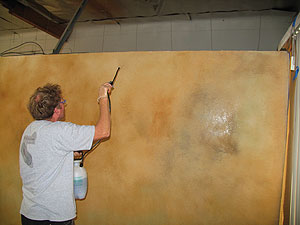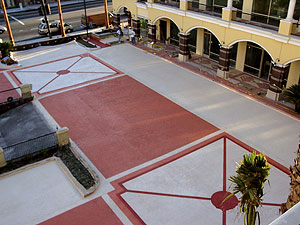Concrete Microtopping
These new toppings go down easy and look great!
by Amy Johnson
 |
 |
| This fireplace and table were both created with sprayed Bella Vernici
overlays and then colored with stains. Grout lines on the table were
created with masking tape |
used to have little in common. Painters generally concentrated on walls and ceilings, while concrete contractors stuck with driveways and sidewalks. But growing demand for new decorative techniques and explosive growth in materials technology have blurred the distinction between the two specialties.
Take, for example, sprayable concrete toppings. These materials offer painters new tools for refreshing old surfaces, applying faux finishes and creating unique textured surfaces.
Ordinary concrete is composed of fine aggregate (sand) and coarse aggregate (stone, gravel), cementitious materials such as portland cement, and water. Sprayable concrete toppings are variations on this recipe. These toppings are based on cement, with various other ingredients that make them sprayable and give them texture. The product, ready to apply, is about the same consistency as paint or fine plaster.
For example, Sgraffino, made by Colormaker, a manufacturer of cementitious toppings located in Vancouver, B.C., is a polymer-modified concrete composed of cement, sand and acrylic. The acrylic makes it possible to spray Sgraffino in “paper-thin” layers, according to sales manager Victor Pachade, while the sand imparts texture.
 |
| Gary Jones adds color to Colormaker’s Sgraffino overlay. |
Bella Vernici Overlay Compound from Bella Vernici Studios in Texas is similarly based on portland cement. Rodney Ray, the company’s art director, says the compound is specifically designed to prepare any rigid substrate to accept a coloring stain.
Another polymer-modified cement product, Ultra Surface Spray-Top System from Concrete Solutions in San Diego, clearly straddles the line between paint and concrete. The product is promoted for refinishing traditional concrete applications such as driveways, but a key feature is that it can be applied like paint.
 What are the capabilities — and benefits — of these materials? They offer painters a way to renovate and add color to existing concrete, a widely used building material for which, until recently, there have been few color coating options. What are the capabilities — and benefits — of these materials? They offer painters a way to renovate and add color to existing concrete, a widely used building material for which, until recently, there have been few color coating options.
These toppings allow a virtually unlimited color palette.
They can also be troweled and textured for added dimension. They can be sprayed through a stencil to create intricate designs. And because they are applied in such a thin layer, dimensional details from the original surface are reflected, making sprayable concrete toppings ideal for rehabbing stamped or saw-cut concrete. Ray points out that toppings “go on like a really fine plaster and don’t require any type of mechanical reinforcement like concrete would.” The toppings are also valuable where profiles like crown moldings or sculptural details need to be retained.
Sprayable concrete toppings are also suitable for application on other surfaces besides concrete. With proper surface preparation and priming they may be used on any rigid horizontal or vertical surface, including ceramic tile, Formica and drywall. Pachade adds wood to the list, but cautions that the topping will crack if the wood flexes. Concrete Solutions cites the use of toppings over foam shapes to create the look of concrete structures without the weight.
As with any decorative technique, successful results depend largely on careful preparation. “Masking is extremely important,” Pachade says, “This stuff sticks!”
Specifics for surface preparation may vary from product to product and substrate to substrate, but there are some commonalities. First, the surface must be structurally sound, clean, and free of dust, dirt and debris such as drywall residue, mold and petroleum-based products. In short, there should be no contaminant between the substrate and the topping. Bella Vernici recommends scraping the surface to smooth rough spots and then thoroughly washing the substrate with soap and water. If there are still pinholes or rough areas, a skim coat may be applied before priming.
 |
| This courtyard was sprayed with Concrete Solutions’ Ultra Surface
Spray-Top System. |
The makers of all three materials described here stress the importance of priming. The primer creates the bond between the original substrate and the concrete topping. Colormaker recommends applying acrylic primer with a sprayer and then, on horizontal surfaces, spreading with a broom or mop for complete coverage. The first coat of primer should be allowed to dry eight hours or overnight. The second coat can be applied the next day and the topping installed as soon as the primer appears clear and is touch-dry. Bella Vernici supplies a bonding primer for application over concrete and recommends a transitional primer topped with bonding primer to prepare substrates other than concrete for overlays.
At this point, the toppings may be sprayed or troweled on. Pachade recommends troweling for areas smaller than 1,000 square feet. He also recommends troweling for vertical surfaces. The ease and speed of spraying make it the preferred method for larger areas.
Concrete Solutions Web site claims, “If you know how to spray paint, you can apply Spray-Top.”
 |
 |
| Applying the Ultra Surface Strap-Top System. |
Of course, the greatest appeal of concrete toppings to a painter is the color potential. There are various ways toppings can be colored. One is to simply mix a powdered oxide pigment into the topping in a bucket with a drill and mixer with rounded blades. These pigments can be added as supplied or mixed on site to create a custom color. The colored topping is sprayed on just like paint, and, like paint, if the customer doesn’t like it, the topping can be recoated with a new color.
The cementitious makeup of sprayable concrete toppings creates other coloring options more commonly associated with concrete than paint. Acid-based stains react with the lime in the cement to create a natural mottled look. An acid-stained surface gives the impression of depth. In contrast, a solvent-based dye gives a more uniform surface look. Water-based stains may also be used, but Pachade recommends them only for horizontal applications, as they tend to run down vertical surfaces. Bella Vernici also supplies liquid oxide colors that can be sprayed onto the topping (which must be well hydrated) or dripped or drizzled on for more varied effects.
These coloring techniques are especially dramatic when used with stencils. Stains can be applied as a stencil is “weeded” — different parts of the pattern are removed to apply different colors. Acid stains thickened with gel are less likely than liquids to bleed under the stencil. A stencil can also be used with different colors of overlay. The stencil is placed after the first overlay is sprayed and then a second layer of topping in a contrasting or complementary color is sprayed through the stencil.
Painters are not about to become concrete contractors, but now they certainly have a new option for expanding their business. They can color or correct stained or discolored concrete just the way they improve worn or dated painted surfaces. Concrete Solutions claims, “Once it is dry, Spray-Top looks similar to a professionally finished color hardener or integral colored concrete job. Even the most experienced concrete finisher will have difficulty telling the difference.”
But besides opening up new business opportunities, sprayable concrete toppings open up new creative opportunities as well. Rodney Ray says, “How easy are these products to use? They are extremely user-friendly, but they are advanced enough to appeal to even the most skilled artisan.”

|

